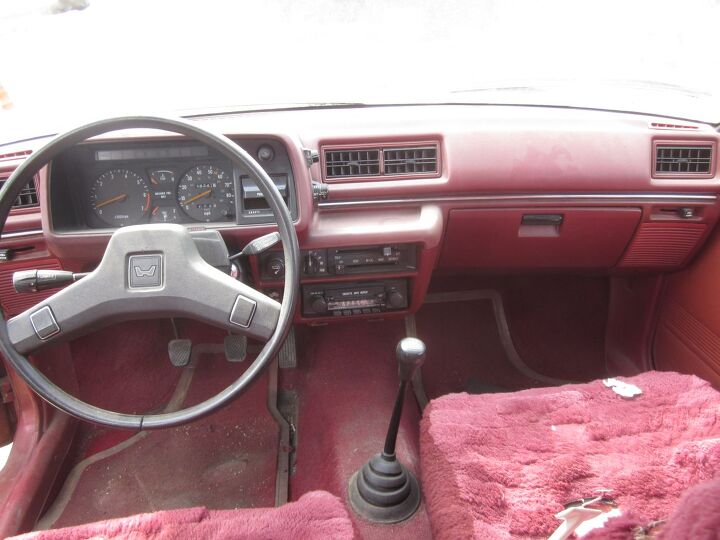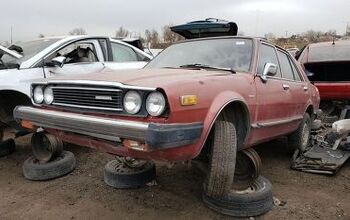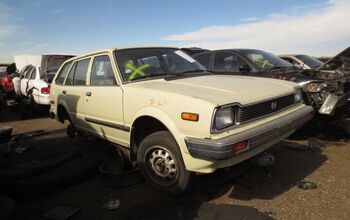Junkyard Find: 1980 Honda Civic 1500 GL

Back in the Malaise Era, why did anyone buy a Corolla (or an Omni or GLC or any other miserable underpowered econobox) instead of a Civic? Somehow, Soichiro‘s little car managed to be economical, reliable, and fun to drive. Most of the second-gen (1980-83) Civics have long since been crushed, not being as solid as their successors and also not attracting a following of collectors willing to do any sort of restoration, so you don’t see many of them in the junkyards these days. Here’s one that managed to hang on for more than 30 years before taking that final tow-truck ride.
I’ve owned a couple of examples of this generation of Civic, and it’s startling how Honda made 67 horsepower (the base 1300 made just 55) feel like (nearly) enough. Even the Chevette had more power than this thing!
Thing is, if anything went wrong with the nightmarishly complex emission-control system on the carbureted CVCC Hondas, you were screwed. This diagram is dirt simple next to the CVCCs of the mid-1980s.
This one is pretty well beat, but should have had a few years left in it. Blown head gasket? Bad suspension?

Murilee Martin is the pen name of Phil Greden, a writer who has lived in Minnesota, California, Georgia and (now) Colorado. He has toiled at copywriting, technical writing, junkmail writing, fiction writing and now automotive writing. He has owned many terrible vehicles and some good ones. He spends a great deal of time in self-service junkyards. These days, he writes for publications including Autoweek, Autoblog, Hagerty, The Truth About Cars and Capital One.
More by Murilee Martin
Latest Car Reviews
Read moreLatest Product Reviews
Read moreRecent Comments
- Lichtronamo Watch as the non-us based automakers shift more production to Mexico in the future.
- 28-Cars-Later " Electrek recently dug around in Tesla’s online parts catalog and found that the windshield costs a whopping $1,900 to replace.To be fair, that’s around what a Mercedes S-Class or Rivian windshield costs, but the Tesla’s glass is unique because of its shape. It’s also worth noting that most insurance plans have glass replacement options that can make the repair a low- or zero-cost issue. "Now I understand why my insurance is so high despite no claims for years and about 7,500 annual miles between three cars.
- AMcA My theory is that that when the Big 3 gave away the store to the UAW in the last contract, there was a side deal in which the UAW promised to go after the non-organized transplant plants. Even the UAW understands that if the wage differential gets too high it's gonna kill the golden goose.
- MKizzy Why else does range matter? Because in the EV advocate's dream scenario of a post-ICE future, the average multi-car household will find itself with more EVs in their garages and driveways than places to plug them in or the capacity to charge then all at once without significant electrical upgrades. Unless each vehicle has enough range to allow for multiple days without plugging in, fighting over charging access in multi-EV households will be right up there with finances for causes of domestic strife.
- 28-Cars-Later WSJ blurb in Think or Swim:Workers at Volkswagen's Tennessee factory voted to join the United Auto Workers, marking a historic win for the 89- year-old union that is seeking to expand where it has struggled before, with foreign-owned factories in the South.The vote is a breakthrough for the UAW, whose membership has shrunk by about three-quarters since the 1970s, to less than 400,000 workers last year.UAW leaders have hitched their growth ambitions to organizing nonunion auto factories, many of which are in southern states where the Detroit-based labor group has failed several times and antiunion sentiment abounds."People are ready for change," said Kelcey Smith, 48, who has worked in the VW plant's paint shop for about a year, after leaving his job at an Amazon.com warehouse in town. "We look forward to making history and bringing change throughout the entire South." ...Start the clock on a Chattanooga shutdown.





















































Comments
Join the conversation
I am the original owner of a 1981 Honda Civic 1500 GL Hatchback, great condition, Blue, roof rack factor stylish addition, new tires and radiator with 149,000 miles and gentle use, for sale in Hawaii
The comment thread here is old, but I can't help but chime in, as I had an identical 1980 model in the mid 80s, except with Hondamatic and the pink plush seats(it also had the standard instrument cluster, without the tach). I'd previously had a '74 civic (orange), and the second generation model was quite a bit more substantial, although of course not as idiosyncratic or interesting. Even with the modest hp and the Hondamatic, it didn't feel underpowered (but then, I was coming from the '74). Although it did have some of that bubble up under the paint rust seen the junkyard car, it was quite sturdy, withstanding duty on 1980s NYC lunar landscape roads and even being rearended by Plymouth Fury taxicab without significant damage. I did have to sink $$ in the car right away for transmission work, and a little bit more at some point for a waterpump (the wheels on these broke on all 3 civics I had), contrary to some comments here, it was quite reliable and didn't need much attention. Note to today's car designers. Observe the relatively plain styling of this vehicle and relatively box-shaped passenger and cargo area. This maximized passenger room and enabled the driver to see other cars and pedestrians on either side of the car and on the rear, without use of external cameras or other aids.